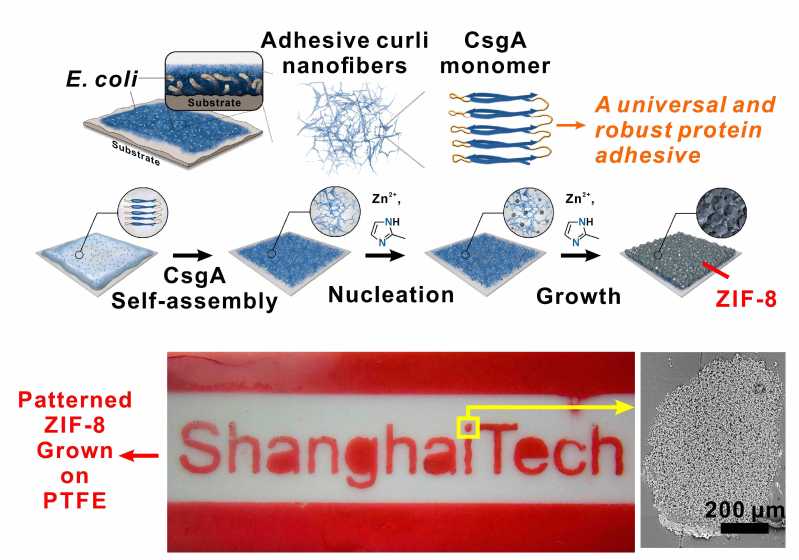Research groups led by Professor Li Tao and Zhong Chao from the School of Physical Science and Technology (SPST) at ShanghaiTech University have co-developed a method that can grow metal-organic frameworks (MOFs) on nearly any polymeric surfaces using bacterial adhesive curli nanofibers (CNFs) as a mediator. Their work, "Adhesive Bacterial Amyloid Nanofibers-Mediated Growth of Metal-Organic Frameworks on Diverse Polymeric Substrates" was recently published in Chemical Science, a top chemical journal. The first author, Zhang Cuizheng, is a junior undergraduate student from Professor Li Tao's group. Li Yingfeng. the co-first author, is a 5th year graduate student from Professor Zhong Chao's group. Professors Tao Li and Chao Zhong are both corresponding authors of this paper.
As a class of extremely diverse porous materials, metal-organic frameworks (MOFs) have shown great promises in numerous applications such as gas storage, sorption-based separation and catalysis. Yet, the development of other high value-added products like separation membranes and wearable devices, etc. demands the growth of MOFs on various flexible polymer substrates. However, this is an extremely challenging task because many polymer surfaces are chemically inert thus not suitable for MOF growth. So far, there is a lack of a generalizable method to surmount this challenge.
In nature, the biofilm of Escherichia coli (E. coli) can tightly anchor on many biotic and abiotic substrate surfaces to protect the bacteria from environmental changes. This superior adhesive capability can be attributed to numerous CNFs self-assembled from CsgA protein secreted by E. coli. Inspired by this phenomenon, two research groups used purified CsgA protein as a universal coating for a variety of polymeric substrates. Meanwhile, the remaining carboxylate, amino and imidazolate groups presented on the protein surfaces served as nucleation centers for crystalline MOFs to grow.
The research teams first investigated the crystallization mechanism of a model MOF, ZIF-8 on CNFs using transmission electron microscopy (TEM) and atomic force microscopy (AFM). The results reveal that ZIF-8 nuclei indeed nucleate on CNFs, suggesting that CNFs can be used as the nucleation center for MOF growth. Next, utilizing the universal adhesion capability of CNFs, ZIF-8 thin films were densely grown on 12 common polymeric substrates with drastically different functionality and surface properties. These substrates include some of the notoriously non-stick or chemically inert polymers such as polytetrafluoroethylene (PTFE or Teflon), polyvinylidene fluoride (PVDF) and polystyrene (PS), etc. Compared to non-modified surfaces, the MOF coverages were dramatically improved. In the case of PVDF, nearly 100-fold MOF coverage enhancement was achieved. This powerful method was further extended to grow MOFs on plastic tubes, fabrics and even plastic objects with very complex geometric shapes. Combining protein patterning technique, Zhang et al. successfully fabricated a pattern forming the word “ShanghaiTech using MOF particles on a non-stick Teflon surface.
To tackle one of the most challenging industrial separation processes, propylene/propane (C3H6/C3H8) separation, Zhang successfully fabricated a sub-micron defect-free ZIF-8 thin film composite (TFC) membrane on a microporous PVDF support using this method. Due to the ultrathin nature of the selective ZIF-8 layer, this membrane exhibited very high C3H6 permeation and high C3H6/C3H8 separation selectivity which are two most important attributes for membrane gas separation. Compared to the traditional cryogenic distillation process, this new technology may significantly reduce the overall energy consumption, making it a “greener” process.
The work is a result of interdisciplinary collaboration among experts in fields of biomaterials, porous materials and chemical engineering, etc.which fully reflects the importance of multidisciplinary cross-communication encouraged by ShanghaiTech University. It is worth noting that the first author, Zhang Cuizheng, is currently a junior undergraduate student in the SPST at ShanghaiTech University. Influenced by the strong academic atmosphere of the university, he joined the Li group when he was just a freshman and immediately picked up an independent research project on his own. During two years of research, he proactively communicated and cooperated with senior graduate student Li Yingfeng. His motivation and courage to break the traditional boundary between undergraduate and graduate research led to this achievement. At the same time, this also reflects ShanghaiTech's determination to be a innovative university aiming to provide the strongest support for all of their students.
This work was supported by start-up funding from ShanghaiTech University, Young Overseas High-Level Talents Introduction Plan, the "Dawn" Program of Shanghai Municipal Education Commission, Shanghai Pujiang Program of Shanghai Science and Technology Committee (STCSM), National Natural Science Foundation of China and the Joint Funds of the National Natural Science Foundation.

Figure 1. A schematic illustration of curli nanofibers-mediated growth of MOFs.

Figure 2. MOF crystals (red) grown on various polymeric substrates with different morphologies.

